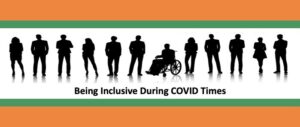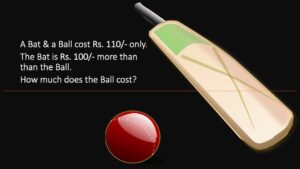
COVID times are difficult times. They are times of stress, crisis, difficulties, worries or what may be called as cognitive load. Under such circumstances when our system 2 is busy, system 1 takes over and our decisions may be biased. During these times it is more important to be deliberate an be inclusive in our behaviours.
Bias Defined
Biases are shortcuts that our brain creates to make sense of this world. At any moment in time, our brain is exposed to 11 million bits of data, and it has the capacity to process 40 bits. Do your maths and 11 million bits minus 40 bits is what is processed by our unconscious mind
Without thinking too much try and answer the following :

If the first think that came to your mind is Rs 10/- then you are part of the majority. This question has been asked muckiest
Daniel Kahneman, a psychologist, behavioural economist, Nobel laureate, has popularised the concept of System 1 and System 2 of our brains. System is the fast brain which made you say the ball costs Rs. 10/- in the previous question. When asked to think again, the System 2 in your brain jumped into action and told you it is Rs. 5/-. Any decision which takes longer time, where you have to deliberate and consciously make calculations or make choices is by system 2.
Talking about Bias & Stereotype
The moment we talk about Bias, we get the notion of a “bad person”. We are all biased and all biases are not bad. When we allow our biases to take decisions about other people, the decisions could be “bad”.
Stereotypes are biases which we have about people or group of people and they are based on our experiences, socialisation. e.g. if I say someone belongs to South India, the picture of a person with dark complexion flashes in the mind. Similarly if I say someone is handicapped, there is high probability that you visualise a person on wheelchair, while the other person may have lost her / his hearing.
Sources of stereotypes
- Social Conditioning : What I saw or experienced or heard while growing up. e.g. my mother was a homemaker and hence my bias is that women are the primary care takers at home. Being aware of this bias and consciously working on it would help me make better decisions.
- Belief system: The beliefs that I carry, because I was overtly told or covertly exposed to it. e.g. “Men are better at handling finances.” is a belief most of us grew up with. As a woman when I have to buy property, I would turn to the men in the family to help me make the decision.
- Number of assumed truths. For many years I was under the impression that the only man-made structure visible from moon is the Great Wall of China, until I came to know, that we cannot see any human-made structure from moon. Similarly, we all know government spends sizeable amount of money on anti-terrorist activities. This even though there are more casualties due to pot-holes on roads than by terrorist activities.
Talking more about stereotype impacting us
Here’s another quiz question for you.

If you got the answer as “the Neurosurgeon is the Mother”, congratulate yourself, you are amongst the very few who got it right.
Flipping the question would make it even more difficult. A women and a daughter meet with an accident and women dies on the spot and the daughter is critical. When she’s brought to the hospital the nurse looks at the girl and starts crying “Someone save my daughter”. How is it possible? If you thought the nurse may be the father, you are amongst the very few who can think of a man as nurse. This despite, many of us having experienced a male nurse. System 1 is tuned to think nurse as a woman.
Why is it important now
Now that we have an idea about the difference in system 1 & System 2, let’s understand how is it impacting us during the COVID times. During times of crisis or stress or tension, system 1 takes over which would lead us to take most decisions based on stereotypes
Some of the profitable businesses, like Nokia, Polaroid, Swiss Air are classic examples of how homogeneity leads to short-sightedness and hence not be able see the changes at ground level. This ultimately leads to downward spiral in business.
Some of the challenges expressed by those who participated in our WFH survey
- Those who have a good internet connection end up taking up work from those who do not have
- The challenge of sharing resources with children for their classes.
To become more inclusive in our approach
- Slow down in your decisions; Challenge your assumptions : e.g. challenge an assumption that a single man will be available all the time. We cannot assume the single man may not have elders who he is taking care of. Ask, don’t assume. This way we can check our biases ruling our decision
- Include everyone in decision making – give everyone an opportunity to speak. Invite your colleagues to speak esp those who are quieter ones (could be introverts). Diversity of mind, diversity of perspective will lead us to decision which are less biased. If the other person is not good at English or takes little longer to put together her / his thoughts do listen patiently.
- Employee socialisation: Creating opportunities employee engagement through employee socialisation. The water-cooler conversations, the other socialisations, celebrations,
- One on ones with each employee. Have one-on-one to understand each one and express your willingness to support
- Be intolerant of behaviours that create a feeling of exclusion. Jokes, mockery. Any kind of racial/ religious slurs, micro aggressions cannot have place in on-line connections. The impact of such behaviour during these times is much more than you can imagine, more so because each one of your employees are also going through some tough times.
Final word
Being deliberate in our inclusive behaviours has never been more important as each one of us are going through tough times and the our System 2 is occupied with lot of stuff. This leaves system 1 to take over and we end up making sub-optimal decision.
